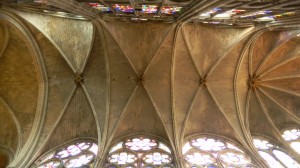Today we marvel at Gothic cathedrals’ stone and stained glass. But when they were new, the intellectual ferment that happened around them was just as interesting.
Gothic cathedrals can’t be separated from medieval philosophy–people built the great Gothic cathedrals to represent their ideas of how the universe is integrated. But their world was changing as they were building them. Come and explore the minds behind the stone and glass.
The world was simpler before the first Gothic cathedrals were built just before the mid 12th century. Philosophy could reflect that simplicity. Anselm of Canterbury (1033-1109) and William of Champeaux felt that universal categories are more real than individual things that embody them. We learn by divine illumination, which allows us to apprehend general concepts like goodness, beauty, justice, tree, and fruit. They inherited this idea from Plato and Saint Augustine. But the world was getting more complex in the 12th and 13th centuries.
People were questioning this top-down view of reality. Roscelin of Compiege (ca. 1050-1123/1125) and Abelard (1079-1142) argued that we learn the particular thing first. A child perceives individual trees, and later forms a general concept of them. People first learn about things through their senses. They then notice similarities between several things (trees are tall and green and they have a trunk and branches), and lump them into one idea.
Christian philosophy had traditionally favored the general idea over the individual thing. God created the world as a system of general types, which each individual is classified under. Romanesque cathedrals fit this view of reality well. But people in the growing and increasingly commercial and literate towns of the 12th century were creating a more dynamic world in which the individual thing had its own reality.
This was potentially threatening because, taken too far, it would flout the order that God created. In the next post, we’ll see Gothic style’s beautiful compromise between the old focus on the general order and the new bustling worlds of towns.



Comments on this entry are closed.